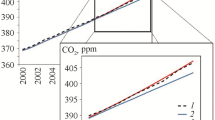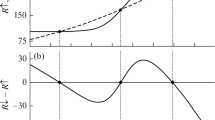Abstract
Analytical solutions of globally averaged energy-balance model to estimate the efficiency of controlled forcing on the climate in the result of sulfate aerosol emissions into the stratosphere are obtained. According to obtained results, the sulfate aerosol emissions, needed to prevent the warming, make up from 2 to 12 Mt S/year in the end of the 21st century depending on the anthropogenic impact scenario and aerosol parameters. In the case of the cessation of such compensative emissions of sulfate aerosols, the global temperature increase rate may reach 3 K per decade, that is several times more than values, derived when taking account of greenhouse effect only.
Similar content being viewed by others
References
M. I. Budyko, Climate Change (Gidrometeoizdat, Leningrad, 1974) [in Russian].
A. V. Eliseev and I. I. Mokhov, “Influence of Volcanic Activity on Climate Change in the Past Several Centuries: Assessments with a Climate Model of Intermediate Complexity,” Izv. Akad. Nauk, Fiz. Atmos. Okeana, No. 6, 44 (2008) [Izv., Atmos. Oceanic Phys., No. 6, 44 (2008)].
A. V. Eliseev and I. I. Mokhov, “Estimating the Efficiency of Mitigating and Preventing Global Warming with Scenarios of Controlled Aerosol Emissions into the Stratosphere,” Izv. Akad. Nauk, Fiz. Atmos. Okeana, No. 2, 45 (2009) [Izv., Atmos. Oceanic Phys., No. 2, 45 (2009)].
A. V. Eliseev, I. I. Mokhov, and A. A. Karpenko, “Influence of Direct Sulfate-aerosol Radiative Forcing on the Results of Numerical Experiments with a Climate Model of Intermediate Complexity,” Izv. Akad. Nauk, Fiz. Atmos. Okeana, No. 5, 43 (2007) [Izv., Atmos. Oceanic Phys., No. 5, 43 (2007)].
Yu. A. Israel, “An Efficient Way to Regulate the Global Climate is the Main Objective of the Solution of the Climate Problem,” Meteorol. Gidrol., No. 10 (2005) [Russ. Meteorol. Hydrol., No. 10 (2005)].
Yu. A. Israel, I. I. Borzenkova, and D. A. Severov, “Role of Stratospheric Aerosols in the Maintenance of Present-day Climate,” Meteorol. Gidrol., No. 1 (2007) [Russ. Meteorol. Hydrol., No. 1, 32 (2007)].
I. I. Mokhov and V. K. Petukhov, Parametrization of Outgoing Long-wave Radiation for Climate Models, Preprint (IFA AN SSSR, Moscow, 1978).
S. S. Khmelevtsov, Climate Investigation Using Energy-balance Models (Gidrometeoizdat, Leningrad, 1988) [in Russian].
V. Brovkin, V. Petoukhov, M. Claussen, et al., “Geoengineering Climate by Stratospheric Sulfur Injections: Earth System Vulnerability to Technological Failure,” Climate Change, No. 3–4, 92 (2006).
A. V. Chernokulsky, A. V. Eliseev, and I. I. Mokhov, “Geoengineering Efficiency: Preliminary Assessment for Year 2100 with an Energy-balance Climate Model,” in Research Activities in Atmospheric and Oceanic Modelling, Ed. by J. Cote (World Climate Research Programme, Geneva, 2008).
Climate Change, 2001: The Scientific Basis. Contribution of Working Group I to the Third Assessment Report of the Intergovernmental Panel on Climate Change, Ed. by J. T. Houghton, Y. Ding, D. J. Griggs, et al. (Cambridge Univ. Press, Cambridge, New York, 2001).
Climate Change, 2007:The Physical Science Basis, Ed. by S. Solomon, D. Qin, M. Manning, et al. (Cambridge Univ. Press, Cambridge, New York, 2007).
P. J. Crutzen, “Albedo Enhancement by Stratospheric Sulfur Injections: A Contribution to Resolve a Policy Dillema,” Climate Change, No. 3–4, 77 (2006).
D. J. Hofmann and S. Solomon, “Ozone Destruction through Heterogeneous Chemistry Following the Eruption of El Chichon,” J. Geophys. Res., No. D4, 94 (1989).
C. D. Keeling, J. F. S. Chine, and T. P. Whorf, “Increased Activity of Northern Vegetation Inferred from Atmospheric CO Measurements,” Nature, 382 (1996).
H. D. Matthews and K. Caldeira, “Transient Climate-carbon Simulations of Planetary Geoengineering,” Proc. Nat. Acad. Sci., No. 24, 104 (2007).
I. I. Mokhov and A. V. Eliseev, “Geoengineering Efficiency: Preliminary Assessment with a Climate Model of Intermediate Complexity,” in Research Activities in Atmospheric and Oceanic Modelling, Ed. by J. Cote (World Climate Research Programme, Geneva, 2008).
G. Myhre, A. Myhre, and F. Stordal, “Historic Evolution of Radiative Forcing of Climate,” Atmos. Environ., 35 (2001).
G. R. North, “Theory of Energy-balance Climate Models,” J. Atmos. Sci., No. 32, 11 (1975).
P. J. Rasch, P. J. Crutzen, and D. B. Coleman, “Exploring the Geoengineering of Climate Using Stratospheric Sulfate Aerosols: The Role of Particle Size,” Geophys. Res. Lett., No. 2, 35 (2008).
A. Robock, “Volcanic Eruptions and Climate,” Rev. Geophys., No. 2, 38 (2000).
S. H. Schneider, “Earth Systems Engineering and Management,” Nature, No. 6868, 409 (2001).
S. J. Smith, H. Pitcher, and T. M. L. Wigley, “Global and Regional Anthropogenic Sulfur Dioxide Emissions,” Glob. Planet. Change, 29 (2001).
S. Tilmes, R. Miller, and R. Salawitch, “The Sensitivity of Polar Ozone Depletion to Proposed Geoengineering Schemes,” Science, No. 5880, 320 (2008).
K. E. Trenberth and A. Dai, “Effects of Mount Pinatubo Volcanic Eruption on the Hydrological Cycle as an Analog of Geoengineering,” Geophys. Res. Lett., No. 15, 34 (2007).
T. M. L. Wigley, “A Combined Mitigation/Geoengineering Approach to Climate Stabilization,” Science, No. 5798, 314 (2006).
Author information
Authors and Affiliations
Additional information
Original Russian Text © A.V. Chernokul’skii, A.V. Eliseev, I.I. Mokhov, 2010, published in Meteorologiya i Gidrologiya, 2010, No. 5, pp. 16–26.
About this article
Cite this article
Chernokul’skii, A.V., Eliseev, A.V. & Mokhov, I.I. Analytical estimations of the efficiency of climate warming prevention by controlled aerosol emissions into the stratosphere. Russ. Meteorol. Hydrol. 35, 301–309 (2010). https://doi.org/10.3103/S1068373910050018
Received:
Published:
Issue Date:
DOI: https://doi.org/10.3103/S1068373910050018




